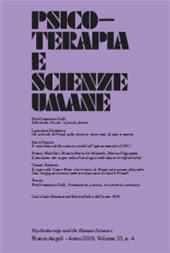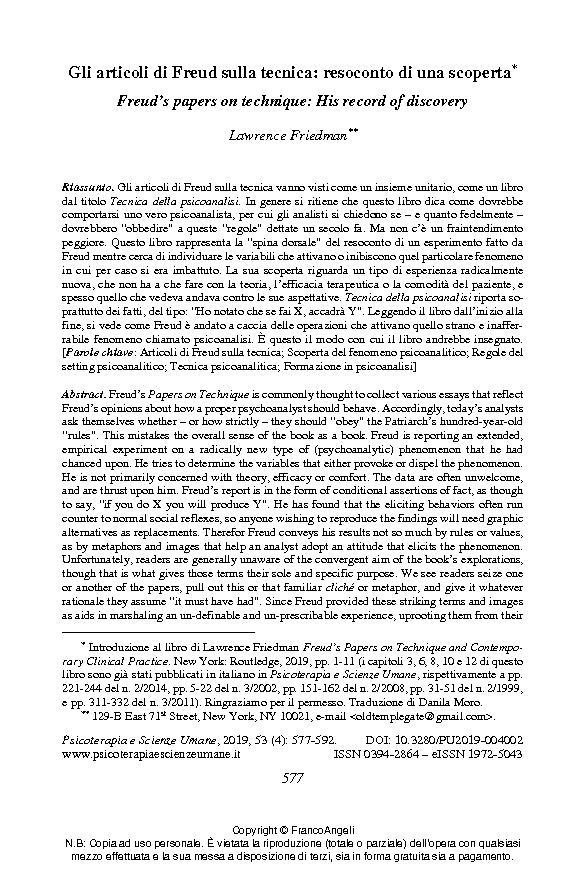Gli articoli di Freud sulla tecnica : resoconto di una scoperta
577-592 p.
Gli articoli di Freud sulla tecnica vanno visti come un insieme unitario, come un libro dal titolo Tecnica della psicoanalisi. In genere si ritiene che questo libro dica come dovrebbe comportarsi uno vero psicoanalista, per cui gli analisti si chiedono se - e quanto fedelmente - dovrebbero "obbedire" a queste "regole" dettate un secolo fa. Ma non c'è un fraintendimento peggiore. Questo libro rappresenta la "spina dorsale" del resoconto di un esperimento fatto da Freud mentre cerca di individuare le variabili che attivano o inibiscono quel particolare fenomeno in cui per caso si era imbattuto. La sua scoperta riguarda un tipo di esperienza radicalmente nuova, che non ha a che fare con la teoria, l'efficacia terapeutica o la comodità del paziente, e spesso quello che vedeva andava contro le sue aspettative. Tecnica della psicoanalisi riporta soprattutto dei fatti, del tipo: "Ho notato che se fai X, accadrà Y".
Leggendo il libro dall'inizio alla fine, si vede come Freud è andato a caccia delle operazioni che attivano quello strano e inafferrabile fenomeno chiamato psicoanalisi. È questo il modo con cui il libro andrebbe insegnato. [Testo dell'editore].
Freud's Papers on Technique is commonly thought to collect various essays that reflect Freud's opinions about how a proper psychoanalyst should behave. Accordingly, today's analysts ask themselves whether - or how strictly - they should "obey" the Patriarch's hundred-year-old "rules". This mistakes the overall sense of the book as a book. Freud is reporting an extended, empirical experiment on a radically new type of (psychoanalytic) phenomenon that he had chanced upon. He tries to determine the variables that either provoke or dispel the phenomenon. He is not primarily concerned with theory, efficacy or comfort. The data are often unwelcome, and are thrust upon him. Freud's report is in the form of conditional assertions of fact, as though to say, "if you do X you will produce Y". He has found that the eliciting behaviors often run counter to normal social reflexes, so anyone wishing to reproduce the findings will need graphic alternatives as replacements.
Therefor Freud conveys his results not so much by rules or values, as by metaphors and images that help an analyst adopt an attitude that elicits the phenomenon. Unfortunately, readers are generally unaware of the convergent aim of the book's explorations, though that is what gives those terms their sole and specific purpose. We see readers seize one or another of the papers, pull out this or that familiar cliché or metaphor, and give it whatever rationale they assume "it must have had". Since Freud provided these striking terms and images as aids in marshaling an un-definable and un-prescribable experience, uprooting them from their precise place in the inquiry turns guide-posts into loose lumber. The result is fruitless debate cir-cling personal taste and opinion, and tragic loss of access to a delicate and unnatural experience that will never be encountered without a deliberate plan.
(This article is a modified version of the Introduction to Lawrence Friedman' book Freud's Papers on Technique and Contemporary Clinical Practice. New York: Routledge, 2019, pp. 1-11). [Publisher's text].
Ist Teil von
Psicoterapia e scienze umane : LIII, 4, 2019-
Artikel aus derselben Ausgabe (einzeln erhältlich)
-
Informationen
ISSN: 1972-5043
THEMENBEREICHE
KEYWORDS
- Articoli di Freud sulla tecnica, Scoperta del fenomeno psicoanalitico, Regole del setting psicoanalitico, Tecnica psicoanalitica, Formazione in psicoanalisi
- Freud's Papers on Tech-nique, Freud's discovery of the psychoanalytic phenomenon, Frame and rules of the psychoanalytic treatment, Psychoanalytic technique, Psychoanalytic education



